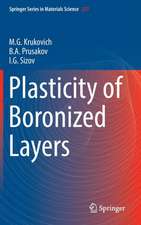Biological Micro- and Nanotribology: Nature’s Solutions: NanoScience and Technology
Autor Matthias Scherge, Stanislav S. N. Gorben Limba Engleză Hardback – 20 mar 2001
| Toate formatele și edițiile | Preț | Express |
|---|---|---|
| Paperback (1) | 945.62 lei 6-8 săpt. | |
| Springer Berlin, Heidelberg – 5 dec 2010 | 945.62 lei 6-8 săpt. | |
| Hardback (1) | 951.91 lei 6-8 săpt. | |
| Springer Berlin, Heidelberg – 20 mar 2001 | 951.91 lei 6-8 săpt. |
Din seria NanoScience and Technology
- 24%
 Preț: 905.79 lei
Preț: 905.79 lei - 18%
 Preț: 1123.35 lei
Preț: 1123.35 lei - 18%
 Preț: 964.71 lei
Preț: 964.71 lei - 18%
 Preț: 1121.76 lei
Preț: 1121.76 lei - 15%
 Preț: 655.60 lei
Preț: 655.60 lei - 18%
 Preț: 1390.11 lei
Preț: 1390.11 lei - 18%
 Preț: 954.31 lei
Preț: 954.31 lei - 15%
 Preț: 645.79 lei
Preț: 645.79 lei - 18%
 Preț: 953.03 lei
Preț: 953.03 lei - 18%
 Preț: 945.79 lei
Preț: 945.79 lei - 15%
 Preț: 639.90 lei
Preț: 639.90 lei - 18%
 Preț: 1109.16 lei
Preț: 1109.16 lei - 23%
 Preț: 779.87 lei
Preț: 779.87 lei - 18%
 Preț: 944.99 lei
Preț: 944.99 lei - 18%
 Preț: 957.62 lei
Preț: 957.62 lei - 18%
 Preț: 971.01 lei
Preț: 971.01 lei - 18%
 Preț: 1232.26 lei
Preț: 1232.26 lei - 18%
 Preț: 960.30 lei
Preț: 960.30 lei - 15%
 Preț: 646.62 lei
Preț: 646.62 lei - 18%
 Preț: 1249.31 lei
Preț: 1249.31 lei - 15%
 Preț: 636.80 lei
Preț: 636.80 lei - 18%
 Preț: 1232.26 lei
Preț: 1232.26 lei - 24%
 Preț: 821.43 lei
Preț: 821.43 lei - 18%
 Preț: 948.92 lei
Preț: 948.92 lei - 24%
 Preț: 1827.89 lei
Preț: 1827.89 lei - 24%
 Preț: 794.21 lei
Preț: 794.21 lei - 18%
 Preț: 953.03 lei
Preț: 953.03 lei - 23%
 Preț: 782.55 lei
Preț: 782.55 lei - 18%
 Preț: 952.57 lei
Preț: 952.57 lei - 18%
 Preț: 948.16 lei
Preț: 948.16 lei - 18%
 Preț: 954.93 lei
Preț: 954.93 lei - 24%
 Preț: 809.40 lei
Preț: 809.40 lei - 23%
 Preț: 781.25 lei
Preț: 781.25 lei - 18%
 Preț: 954.93 lei
Preț: 954.93 lei - 18%
 Preț: 1830.34 lei
Preț: 1830.34 lei - 15%
 Preț: 641.71 lei
Preț: 641.71 lei - 18%
 Preț: 1228.96 lei
Preț: 1228.96 lei - 18%
 Preț: 1120.37 lei
Preț: 1120.37 lei - 18%
 Preț: 956.81 lei
Preț: 956.81 lei - 15%
 Preț: 592.59 lei
Preț: 592.59 lei - 18%
 Preț: 953.65 lei
Preț: 953.65 lei - 18%
 Preț: 954.62 lei
Preț: 954.62 lei - 18%
 Preț: 955.25 lei
Preț: 955.25 lei - 18%
 Preț: 959.19 lei
Preț: 959.19 lei - 18%
 Preț: 953.35 lei
Preț: 953.35 lei - 18%
 Preț: 786.84 lei
Preț: 786.84 lei
Preț: 951.91 lei
Preț vechi: 1160.86 lei
-18% Nou
Puncte Express: 1428
Preț estimativ în valută:
182.14€ • 190.19$ • 150.41£
182.14€ • 190.19$ • 150.41£
Carte tipărită la comandă
Livrare economică 15-29 aprilie
Preluare comenzi: 021 569.72.76
Specificații
ISBN-13: 9783540411888
ISBN-10: 3540411887
Pagini: 320
Ilustrații: XIII, 306 p.
Dimensiuni: 155 x 235 x 23 mm
Greutate: 0.63 kg
Ediția:2001
Editura: Springer Berlin, Heidelberg
Colecția Springer
Seria NanoScience and Technology
Locul publicării:Berlin, Heidelberg, Germany
ISBN-10: 3540411887
Pagini: 320
Ilustrații: XIII, 306 p.
Dimensiuni: 155 x 235 x 23 mm
Greutate: 0.63 kg
Ediția:2001
Editura: Springer Berlin, Heidelberg
Colecția Springer
Seria NanoScience and Technology
Locul publicării:Berlin, Heidelberg, Germany
Public țintă
ResearchCuprins
Introduction.- Physical Principles of Micro- and Nanotribology.- Biological Frictional and Adhesive Systems.- Frictional Devices of Insects.- Microscale Test Equipment.- Nanoscale Probe Techniques.- Microscopy Techniques.- Samples, Sample Preparation and Tester Setup.- Case Study I: Indentation and Adhesion.- Case Study II: Friction.- Case Study III: Material Properties.- Outlook.- Appendix
Recenzii
From the reviews:
"Their book is a valuable addition to the literature on the micromechanics of very thin films … . The discussion is exceedingly well organized and well illustrated; many examples are provided from biological systems … . Overall, the authors have succeeded admirably in providing and informative and thorough text, the publisher has produced an attractive book, and readers will find much material of interest … . I recommend it to anyone who works in the area of micromechanics of friction and lubrication." (Howard A. Stone, Physics Today, June, 2002)
"Their book is a valuable addition to the literature on the micromechanics of very thin films … . The discussion is exceedingly well organized and well illustrated; many examples are provided from biological systems … . Overall, the authors have succeeded admirably in providing and informative and thorough text, the publisher has produced an attractive book, and readers will find much material of interest … . I recommend it to anyone who works in the area of micromechanics of friction and lubrication." (Howard A. Stone, Physics Today, June, 2002)
Textul de pe ultima copertă
Many of the major challenges facing today's engineering science are related to miniaturization. In this field, vital progress can be made by studying Nature's solutions: Insects and other living creatures have solved many of the same problems during their evolution. Biological micro- and nanotribology aims to gather information about friction, adhesion and wear in such biological systems and to exploit this new knowledge, e.g. in the design of micro-electro- mechanical systems, the development of novel types of monolayer lubrication, the invention of new adhesives, and the construction of artificial joints. By employing a combination of approaches from several disciplines -- physics, engineering, tribology, biology, and materials science -- the authors elucidate the principles of a variety of biomechanical systems that rely on frictional surfaces or adhesive secretions to attach parts of the body to one another or to attach organisms to a substrate. This account provides an excellent starting point for engineers and physicists working with biological systems and for biologists studying friction and adhesion. It will also serve as a valuable introduction for graduate students entering this interdisciplinary field of research.
Caracteristici
This is the first book in the interdisciplinary field of nanotribology and biology It will be particularly valuable to graduate students intending to enter this or a related interdisciplinary field Includes supplementary material: sn.pub/extras



















